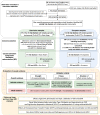Trans-ethnic Mendelian-randomization study reveals causal relationships between cardiometabolic factors and chronic kidney disease
- PMID: 34999880
- PMCID: PMC8743120
- DOI: 10.1093/ije/dyab203
Trans-ethnic Mendelian-randomization study reveals causal relationships between cardiometabolic factors and chronic kidney disease
Abstract
Background: This study was to systematically test whether previously reported risk factors for chronic kidney disease (CKD) are causally related to CKD in European and East Asian ancestries using Mendelian randomization.
Methods: A total of 45 risk factors with genetic data in European ancestry and 17 risk factors in East Asian participants were identified as exposures from PubMed. We defined the CKD by clinical diagnosis or by estimated glomerular filtration rate of <60 ml/min/1.73 m2. Ultimately, 51 672 CKD cases and 958 102 controls of European ancestry from CKDGen, UK Biobank and HUNT, and 13 093 CKD cases and 238 118 controls of East Asian ancestry from Biobank Japan, China Kadoorie Biobank and Japan-Kidney-Biobank/ToMMo were included.
Results: Eight risk factors showed reliable evidence of causal effects on CKD in Europeans, including genetically predicted body mass index (BMI), hypertension, systolic blood pressure, high-density lipoprotein cholesterol, apolipoprotein A-I, lipoprotein(a), type 2 diabetes (T2D) and nephrolithiasis. In East Asians, BMI, T2D and nephrolithiasis showed evidence of causality on CKD. In two independent replication analyses, we observed that increased hypertension risk showed reliable evidence of a causal effect on increasing CKD risk in Europeans but in contrast showed a null effect in East Asians. Although liability to T2D showed consistent effects on CKD, the effects of glycaemic phenotypes on CKD were weak. Non-linear Mendelian randomization indicated a threshold relationship between genetically predicted BMI and CKD, with increased risk at BMI of >25 kg/m2.
Conclusions: Eight cardiometabolic risk factors showed causal effects on CKD in Europeans and three of them showed causality in East Asians, providing insights into the design of future interventions to reduce the burden of CKD.
Keywords: Mendelian randomization; cardiometabolic risk factors; causality; chronic kidney disease; trans-ethnic study.
© The Author(s) 2021. Published by Oxford University Press on behalf of the International Epidemiological Association.
Figures




References
-
- Webster AC, Nagler EV, Morton RL, Masson P.. Chronic kidney disease. Lancet 2017;389:1238–52. - PubMed
Publication types
MeSH terms
Grants and funding
- MC_U137686851/MRC_/Medical Research Council/United Kingdom
- 16896/CRUK_/Cancer Research UK/United Kingdom
- RG/18/13/33946/BHF_/British Heart Foundation/United Kingdom
- RG/13/13/30194/BHF_/British Heart Foundation/United Kingdom
- 212946/Z/18/Z/WT_/Wellcome Trust/United Kingdom
- MC_UU_00002/7/MRC_/Medical Research Council/United Kingdom
- CH/12/2/29428/BHF_/British Heart Foundation/United Kingdom
- MC_UU_00017/1/MRC_/Medical Research Council/United Kingdom
- R01 MD012765/MD/NIMHD NIH HHS/United States
- MC_PC_17228/MRC_/Medical Research Council/United Kingdom
- MC_PC_13049/MRC_/Medical Research Council/United Kingdom
- MC_QA137853/MRC_/Medical Research Council/United Kingdom
- 29186/CRUK_/Cancer Research UK/United Kingdom
- MC_UU_00011/7/MRC_/Medical Research Council/United Kingdom
- R01 DK117445/DK/NIDDK NIH HHS/United States
- MC_UU_00011/1/MRC_/Medical Research Council/United Kingdom
- MC_UU_12026/2/MRC_/Medical Research Council/United Kingdom
- MR/R013942/1/MRC_/Medical Research Council/United Kingdom
- MC_PC_14135/MRC_/Medical Research Council/United Kingdom
- 204623/Z/16/Z/WT_/Wellcome Trust/United Kingdom
- MC_UU_00011/4/MRC_/Medical Research Council/United Kingdom
LinkOut - more resources
Full Text Sources
Medical

